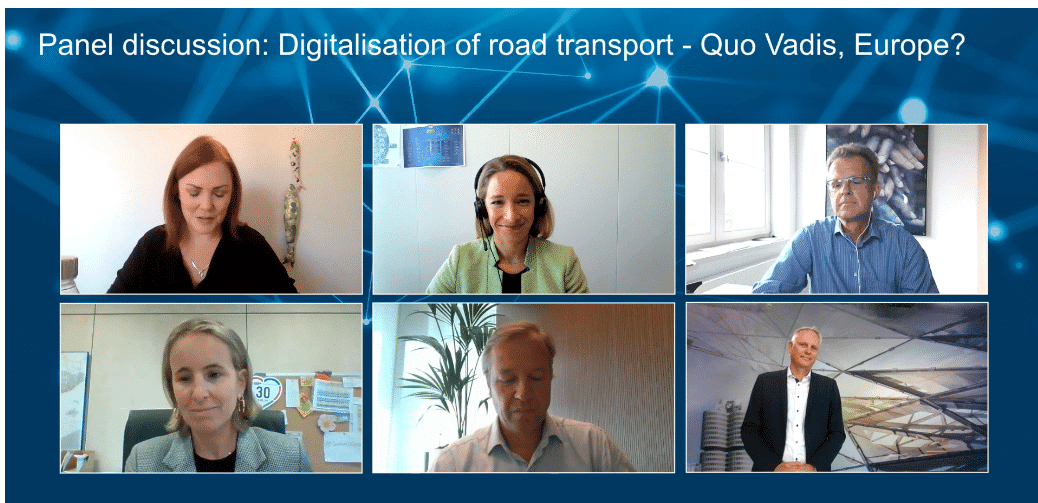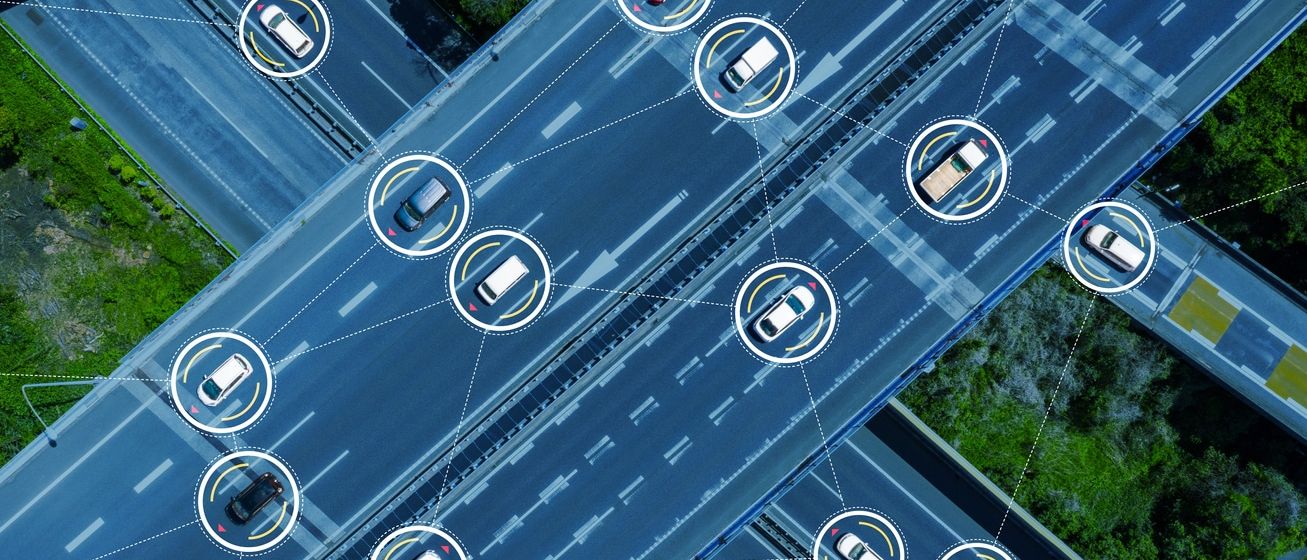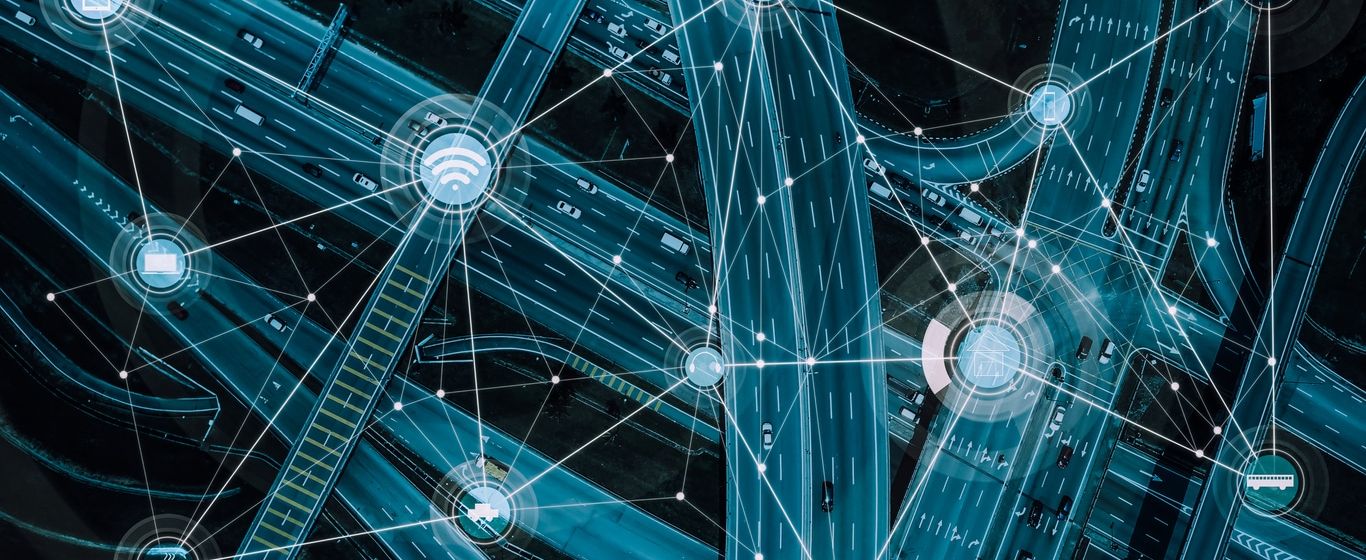
Brussels online conference “5G: Connected Mobility in the Digital Age”
On Tuesday 28 September 2021 the 5G Automotive Association (5GAA) hosted an online conference on “5G: Connected Mobility in the digital age” to discuss the ongoing challenges and opportunities fostered by the digitalization of road transport in Europe.
The event brought together EU representatives, local and national authorities, and the connected automotive ecosystem to the heart of Europe to advance the dialogue on the latest state-of-play and capabilities of Cellular-Vehicle-to-Everything (C-V2X), the EU regulatory framework and the importance of the 5G roll-out, and the crucial role of C-V2X technology to increase traffic safety and efficiency and achieve lower emissions globally.
The Association had the pleasure to have European Commissioner for Transport Adina-Ioana Vălean open the conference and address the attendees. “Our Sustainable and Smart Mobility Strategy sets out milestones for the transformation of our transport system – and Cooperative, Connected, and Automated Mobility will play a key role: by 2030, we expect automation to be deployed at a large scale” stated Commissioner Vălean.
The event welcomed high-level representatives such as Daniel Mes, Cabinet of Executive Vice-President for the European Green Deal Frans Timmermans, Charlotte Nørlund-Matthiessen, Cabinet of Commissioner for Transport Adina-Ioana Vălean, Member of European Parliament Henna Virkkunen, Peter Stuckmann, DG CONNECT Head of Unit Future Connectivity Systems, the European Cyclists’ Federation (Jill Warren, Chief Executive Office), Spain’s Directorate-General for Traffic (Ana Isabel Blanco Bergareche, Associated Deputy Director), the City of Turin (Nicola Farronato, Head of Innovation) and the Swedish Transport Administration (Hamid Zarghampour, Chief Strategist Connected and Automated Transports). It also witnessed a strong ecosystem presence, with speakers from 5GAA members BMW, Stellantis, Volvo Cars, Ford, HERE Technologies, Telefonica, TIM and Huawei.
Rewatch the event in the videos below.

Updated study of spectrum needs for safety related intelligent transportation systems – day 1 and advanced use cases
This report is an update to the 2020 report that presents a study by the 5GAA on the spectrum needs of so-called day-1 and advanced use cases for intelligent transport systems (ITS) as implemented by LTE-V2X and NR-V2X cellular V2X (C-V2X) technologies, respectively.
The study estimates the amounts of bandwidth required for the introduction of use cases for direct communications (via the cellular V2X PC5 interface in the 5.9 GHz band harmonised globally for ITS) and for network-based communications (via the cellular-V2X Uu interface in spectrum designated for use by mobile communication networks).
This update to the report presents spectrum needs estimates for a number of advanced use cases including “Cooperative Perception”, “Vulnerable Road User”, “Group Start” and “Cooperative Lane Merging”, among others.

Live Trial of 5G Connected Car Concept To Launch in Turin, Italy
The international collaboration of tech leaders and public sector on a live connected car trial will pilot new roaming technology for traffic safety on 2 December 2021.
2 DECEMBER 2021, Turin (ITALY) – On 2 December, the City of Turin (Italy) will host a live trial of new driver and pedestrian safety technology allowing near-real-time notification of roadway hazards through 5G-Edge networks. This trial is one of a series conducted internationally by a historic public-private collaboration over the next few years, organized by the 5G Automotive Association (5GAA) and eight member companies representing leading technology companies from around the globe.
“This collaboration between the 5G Automotive Association and its member companies is the perfect example of how we can secure safety on roads and build the future of connected mobility,” said Maxime Flament, CTO of 5GAA. “This time, demonstrated use-cases take place in Europe through 5G and Edge networks—I look forward to seeing more in the future in the United States and other continents.”
The promise of 5G and Edge technology has long been anticipated to deliver new connected services that will revolutionize daily life, with the estimated new economic opportunity stretching into the trillions USD over the next 10-years1. The global connected car market size alone is projected to reach USD 191.83 billion by 2028.
5G transmission speeds and so-called “Edge” servers—locally installed, high-powered computers capable of running Artificial Intelligence programs—open the door to smart city technologies like near real-time traffic management and innumerable other business applications. The connected car concept uses this high-speed and Edge computing technology to communicate with car sensors and pedestrian smartphones, via a user-authorized mobile app—about traffic hazards, like accidents and road construction—to Pedestrian and in-vehicle driver safety and efficient navigation.
“The connected car concept is an important validation of the combined value of Edge, of 5G and IOT,” said Paolo Campoli, Head of Global Service Provider sector at Cisco, “We are so excited to take part in this event that creates a platform for innovation in 5G IOT. The integration of 5G mobility, applications and data processing at the Edge requires expertise from very different domains—expertise that Cisco and Partners can bring. It includes elements of automation, intelligent infrastructure and workloads control, cybersecurity protection and end-to-end application observability. The live trial in Turin is a great opportunity to show how the intersection of Edge, 5G and IOT based on Standards creates a platform to connect Service Providers and Industries.”
This live international trial attempts to solve one of the more technical challenges of making the connected car concept a daily reality. The 5G networks underpinning the concept are managed by communication service providers (CoSPs) according to geography, each with different edge solutions that must be able to communicate without interruption of the V2X applications as drivers cross borders. Roaming services—the ability to make a call regardless of the network—is one early success of multi-mobile network operators (MNO). Demonstrating the connected car concept can work in a roaming scenario is the core objective of the live trial and represents the first of any such attempt in Europe.
“Telecom operators will have to play a major role by enabling applications and services for the connected car ecosystem,” says Shamik Mishra, CTO Connectivity, Capgemini Engineering. He further adds: “Capgemini is excited to bring its innovative federated MEC (Multi-Access Edge Computing) platform and applications to this 5GAA trial to demonstrate the true value of intelligent industry, leveraging data in the vehicles and edge-cloud. The trials serve as a stepping-stone for realizing the potential for automakers to provide services to their connected cars from the network”. The trial will demonstrate how the car manufacturers, MNOs and technology providers come together to help overcome the challenge of when a vehicle moves from one network boundary to another or Inter-MNO handover of MEC service.
The Turin live trial addresses three objectives:
- Objective 1: Multi-MNO scenario: How can a vehicle, which has radio access to MNO A, use a MEC application, which is operated by MNO B -> Interworking between MNO‘s (by NOT losing the benefits of low latency)
- Objective 2: Global operational Availability: How can an OEM as the MEC application developer be sure, especially on a global basis, that a MEC application works in the same way if it’s operated by MNO A, or if it’s operated by MNO B
- Objective 3: Multi-MNO with roaming scenario: Where the two operators can seamlessly transfer the V2X service from one operator to the other as the car OEM moves from one geo to the other in a roaming scenario. Typically, when an in-vehicle driver does a cross-border travel that involves two operators.
One of the key benefits of the trial is the value demonstrated by bringing in a large ecosystem to help develop not only the technology but also build the business case and model that will help drive the market adoption for 5G and C-V2X to help into the digital transformation of smart cities of the future. To succeed in this endeavor, it will need a village and investment from both public and private sectors to help adopt this new technology to provide a quality of life for all citizens.
The city of Turin is delighted to facilitate the 5GAA Multi Operator MEC Trial with its Smart Road infrastructure and the technical support of 5T. We see – Chiara Foglietta, Deputy Mayor for Mobility, Ecological and Digital transition, Innovation says – C-V2X services as fundamental to develop a sustainable and safe mobility for all the citizens, whatever transport means they use. In the future, Turin wants to continue the collaboration with 5GAA and offer its Smart Road infrastructure for further scale in the live traffic within Torino City Lab and the new project “ Turin House of emerging Technologies – CTE NEXT”
“As TIM, we are honored to be hosting in Turin such a challenging trial by leveraging our Innovation Lab competencies and our pre-commercial instances of Edge Cloud,” says Daniele Franceschini TIM VP Innovation, Standard and Portfolio. “The federation model implemented with our partners enables a ‘continuum’ between Edge Cloud instances allowing players from the automotive industry and beyond to benefit from a seamless cloud experience across country boundaries.”
“Greater connectivity speeds, improved hardware and expanded software expertise have opened new opportunities for Stellantis with safety systems being one of the many areas we focus on,” said Mamatha Chamarthi, Head of Software Business and Product Management. “Through smart and strategic partnerships such as 5GAA, we will capitalize on next-generation systems and prove out the technology.”
The demonstration brings new learnings for various players across the value chain and creates a testbed for trying out new 5G connected car services at the Edge in subsequent phases. The Turin Live Trial will run throughout the day on 2 December 2021.
BACKGROUND
In this live trial, Telecom Italia (TIM), Telefonica, BT/EE will demonstrate the NSA 5G networking capabilities and the Edge Cloud solution to deliver connected car use cases at the Edge of their networks for their customers. TIM makes its Innovation Lab facilities available and its commercial 5G network with pre-commercial Edge Cloud specific features such as Local Break Out, that together with the federation of edge platforms in TIM, BT/EE and Telefonica make the use cases available for roaming users from BT/EE and Telefonica.
The three companies are hosting Capgemini’s ENSCONCE MEC platform, built upon the Intel Smart Edge Open toolkit, the Intel® Distribution of OpenVINO toolkit, and Intel hardware to enable connected car use cases at the Edge on 2nd Gen Intel Xeon Scalable processor equipped Cisco Servers. Intel Smart Edge Open (formerly known as OpenNESS) is a royalty-free edge computing software toolkit for building optimized and performant edge platforms.
“The international live trial of building and provisioning Connected Car edge services in a multi-operator scenario is a transformative 5G and Edge use case,” said Renu Navale, Vice President and General Manager of Smart Edge Platforms Division at Intel. “This trial demonstrates the possibilities that 5G connectivity and edge computing can bring to connected car solutions, when the broad ecosystem collaborates and uses Intel technologies such as Xeon processors, Smart Edge Open and OpenVINO.”
Capgemini’s ENSCONCE MEC Platform provides multi-tenancy and multi-MNO MEC federation capabilities. The visual compute applications for pedestrian detection and tracking supported by Capgemini’s Orbital Car Situational Awareness V2X platform. To realize the Active and Passive Vulnerable Road User (VRU) use cases, Cisco provides the Edge infrastructure based on CISCO UCS Servers (the Unified Computing Systems that combines computing, network and management in a cohesive architecture) hosting the ESCONCE platform, used to demonstrate Virtual-RSU and host V2X applications that are based on the Intel Xeon Scalable Processors and Intel HDDL-R Visual Accelerators. Harman International and Capgemini provide the Virtual-RSU and RSE solutions respectively to realize various V2X use cases with location-aware and AI inferencing technologies. Harman also offers V2X Application Server and a 5G enabled TCU that integrates seamlessly with Stellantis/FCA car and hosts V2X applications.
“It is key that operators and industry partners collaborate to explore the technical feasibility and benefits to unlock the new business opportunities and services to our customers. In this project, we are jointly evaluating the potential to federate edge cloud compute capabilities across multiple geographies to support low latency use cases, including key connected car use cases being delivered as 5G edge services in a multi-MNO, multi-OEM environment,” said Sunil Joshi, Senior Manager, Global Roaming Products at BT/EE.
“Telecom operators will have a key role in supporting V2X services and this trial demonstrates the value of leveraging mobile architecture, federating edge platforms and allowing local break out in visited network. Such an approach as defined in the GSMA Operator Platform Group allows customers and developers to deploy their applications across multiple operator domains, and our end users to have the best latency and customer experience when accessing their services,” said Juan Carlos Garcia, Senior Vice-President of technology innovation and ecosystems, Telefonica.
“At Harman, we are focused on building connectivity solutions at the intersection of 5G, V2X and Edge Computing that will build more equity on the road for all users,” said Mahsa Nakhjiri, Director, Product Management. “While these technologies can unlock many new use cases and experiences, the most important element of any solution in this space is safety. As programs such as this one fueled by the collaboration of industry leaders and organizations like 5GAA bring a new degree of safety to users, they will also lead to a higher level of confidence in autonomous vehicles.”
Download the event visual here
Watch the video of the event here
Source: Harbor Research1.

Connected Mobility In Europe: 5G Automotive Association Strives For Digitalized, Sustainable And Safer Roads In The Digital Age
Europe needs a harmonized, future-proof regulatory approach that stimulates innovation and recognizes the industrial timeline and evolutionary path of technologies, conducive of European competitiveness and fostering the development of innovative business models. Innovation through C-V2X technology and sustainability-related opportunities for connected mobility were at the heart of the “5G: Connected Mobility in the Digital Age” conference hosted by the 5G Automotive Association (5GAA).
BRUSSELS (BELGIUM), 29 September 2021 – The 5G Automotive Association (5GAA) organized a conference bringing together EU representatives, public authorities, and the connected automotive ecosystem to the heart of Europe at its latest event, 5G: Connected Mobility in the Digital Age. Main objective? Discuss the ongoing challenges and opportunities brought about by the digitalization of road transport on the continent.
From the latest state-of-play and capabilities of Cellular-Vehicle-to-Everything (C-V2X) to the EU regulatory framework and the importance of the 5G roll-out, the 5GAA-branded conference emphasized the ongoing momentum of the technology in Europe as it supports more and more advanced use cases to ensure safer roads and achieve lower emissions globally.
“When applied to the automotive field, 5G will have the most revolutionary impact by saving millions of lives and reducing accidents on European roads”, 5GAA CTO Maxime Flament said. “The combination of long-range and short-range connectivity C-V2X offers, delivers the optimal setup for safety and efficiency of traffic, in addition to improving environmental footprints. We believe the European Union can achieve its Green Deal climate targets for 2050, if only it boosts the digitalization of its roads – landing a rapid and efficient deployment of 5G along road networks.”
Starting today with LTE-V2X technology, 5G-V2X is paving the way for fully connected and automated mobility. Vehicles and infrastructure can exchange relevant information via LTE-V2X through direct communication mode (not requiring network coverage) or mobile network communications mode, creating a real-time connection between all road users. Many automotive services can be supported by the current global cellular standard LTE-4G, seen as an essential foundation for further progress. As a combination of LTE-V2X and 5G NR, 5G-V2X will enable more advanced connected mobility services and offer a clear path to automated driving – while maintaining service-level interoperability with pre-existing LTE-V2X vehicles. It is thus of utmost importance that the revised Intelligent Transport Systems framework encompasses this tech evolution for Connected and Automated Mobility (CAM) for Europe.
Connected vehicles must reach a critical mass to impact emissions reduction significantly. The Association reiterated that establishing an innovative and investment-friendly regulatory framework that remains technology-neutral will boost Europe’s competitiveness and the number of connected vehicles on the road. As such, a seamless interaction among all stakeholders involved will be pivotal for road operators and public authorities across Europe to meet their policy objectives and enable a smooth service experience across all value-chains – to ensure a smooth 5G roll-out and robust ecosystem cooperation in the global evolving transport ecosystem.
“Our Sustainable and Smart Mobility Strategy sets out milestones for the transformation of our transport system – and Cooperative, Connected, and Automated Mobility will play a key role: by 2030, we expect automation to be deployed at a large scale” stated Commissioner Vălean. “Automation will be a driver to help make 100 European cities climate-neutral by the same date. And we have another important milestone to reach: by 2050, the fatalities for all modes of transport in the EU should be close to zero. Automated mobility is expected to contribute immensely here. My expectations are high, but so is the potential!”
Indeed, the Association had the pleasure to have European Commissioner for Transport Adina-Ioana Vălean open the conference and address the attendees. The event welcomed high-level representatives such as Daniel Mes, Cabinet of Executive Vice-President for the European Green Deal Frans Timmermans, Charlotte Nørlund-Matthiessen, Cabinet of Commissioner for Transport Adina-Ioana Vălean, Member of European Parliament Henna Virkkunen, Peter Stuckmann, DG CONNECT Head of Unit Future Connectivity Systems, the European Cyclists’ Federation (Jill Warren, Chief Executive Office), Spain’s Directorate-General for Traffic (Ana Isabel Blanco Bergareche, Associated Deputy Director), the City of Turin (Nicola Farronato, Head of Innovation) and the Swedish Transport Administration (Hamid Zarghampour, Chief Strategist Connected and Automated Transports). It also witnessed a strong ecosystem presence, with speakers from 5GAA members BMW, Stellantis, Volvo Cars, Ford, HERE Technologies, Telefonica, TIM and Huawei.

5G Automotive Association (5GAA) to participate in the Global Certification Forum (GCF) online conference “C-V2X Certification and the Roadmap to Connected Mobility.”
The 5G Automotive Association (5GAA) is glad to announce its participation to the Global Certification Forum (GCF) webinar “C-V2X Certification and the Roadmap to Connected Mobility” on 6th October 2021, at 4 pm CEST.
The event will bring together industry experts from vehicle manufacturers, equipment vendors, test houses and certification authorities to discuss why certification is key to the effective rollout of C-V2X systems and how it can be implemented successfully now.
Maxime Flament, 5GAA Chief Technology Officer, will hold a session to disclose the current standard landscape and the global market opportunities for connected vehicles. Moreover, he will join a panel discussion on the GCF’s C-V2X certification programme and how it will benefit several actors of the connectivity ecosystem.
High-speed wireless communications between vehicles and infrastructures, especially cellular vehicle-to-everything (C-V2X) communications, are crucial for the development of autonomous vehicles. Proven interoperability between C-V2X devices is essential to ensure the safety and reliability of such systems.
Since 2019, 5GAA and GCF have been collaborating to investigate the principles and framework for a certification programme – designed specifically for C-V2X technologies. A few months ago, the two partners went one step further by signing a new agreement on a programme that will support the drive for interoperability, reliability, and safety of emerging cellular vehicle-to-everything (C-V2X) systems. A programme that will enable manufacturers to certify their C-V2X capable products – including onboard units (OBU) and roadside units (RSU) – for C-V2X PC5 Mode 4 functionality, thus providing a trusted foundation for C-V2X applications globally.
Join the webinar to discover more about the progress to the full interoperability, reliability and safety of emerging C-V2X systems.
More information and agenda of the event here.
Registration here.

Tele-Operated Driving (ToD): System Requirements Analysis and Architecture
Tele-Operated Driving (ToD) technology assists, complements and accelerates semi- and fully automated driving in various scenarios. This 5GAA technical report studies system requirements and corresponding enabler technologies for ToD services using Cellular-V2X (C-V2X) networks. The study covers the vehicle sub-system, ToD operator sub-system, infrastructure sub-system, and C-V2X networks for end-to-end deployment of ToD services. System application layer architectures and the underlying communication network architectures for different ToD use cases and scenarios are presented in this study with the focus on interfaces among different stakeholders and with considerations on service interoperability in multi-OEM, multi-Service Provider, multi-RTA and multi-MNO environments. This study also envisages that market deployment of ToD services will follow a multi-stage roadmap, starting from confined areas, then evolving into dedicated public roads and areas, and finally covering cross-region (long-haul) mobility of automated vehicles.

5G Automotive Association Organises Conference on 5G: Connected Mobility in the Digital Age
To advance the dialogue between high-level institutional and industry stakeholders on current challenges in the field of connected and automated mobility, the 5G Automotive Association (5GAA) is organising an online conference on 28 September 2021, from 9:15 am to 3:00 am CEST.
Representatives from the European institutions, local and national authorities as well as 5GAA members will discuss ongoing challenges for connected and automated mobility and provide solutions by presenting the capabilities and deployment models of the Cellular-Vehicle-to-Everything (“C-V2X”) technology.
AGENDA
Please see the full agenda here.
09:15 – 09:30: Connected Mobility in the Digital Decade
09:30 – 10:15: 5GAA C-V2X visionary roadmap 2030
10:15 – 11:00: The global progress of C-V2X
11:00 – 11:15: Coffee Break
11:15 – 12:15: Panel discussion: Digitalisation of road transport – Quo Vadis, Europe?
12:15 – 13:00: Lunch Break – Exhibition booths
13:00 – 14:00: The path towards road digitalisation
14:00 – 14:45: Panel discussion: Connected Mobility for climate neutrality
14:45 – 15:00: Closing keynote speech
SPEAKERS INCLUDE
- Francesco Lilli, Automotive Research and Advanced Engineering, Global Head of Advanced Connectivity, Stellantis
- Bernardo Campillo Soto, Head of Industry Analysts and Ecosystem, Telefonica
- Wang Xuemin, Vice-President for Standardization & Industry Development, Huawei
- Jovan Zagajac, Product Group Manager, Enterprise Connectivity, Ford Motor Company
- Charlotte Nørlund-Matthiessen, Cabinet of Commissioner for Transport Adina-Ioana Vălean, European Commission
- Johannes Springer, Lead of 5G automotive program, Deutsche Telekom
- Ana Isabel Blanco Bergareche, Directorate-General for Traffic, Spain
- Stephan Durach, Senior Vice President – Connected Company Development, BMW
- Bart Sweerman, Senior Vice President, Services, HERE Technologies GmbH
- Peter Stuckmann, Head of Unit – Future Connectivity Systems, DG CONNECT, European Commission
- Daniele Franceschini, Head of Technology Innovation, Standardization & Portfolio Department, TIM
- Hamid Zarghampour, Chief Strategist, connected and automated transports, Swedish Transport Administration
- Nicola Farronato, Head of Innovation, City of Turin
- Daniel Mes, Member of Frans Timmermans’ Cabinet, European Commission
- Marie Högberg, Head of Connectivity Strategy, Volvo Cars
- Jill Warren, Chief Executive Office, European Cyclists’ Federation
If you have any questions, please get in touch at marcom@5gaa.org

Vehicular Antenna Test Methodology
The rising demand for connected vehicles as well as the ongoing deployment of vehicle-to-vehicle communication has shown that a unified measurement procedure for the communication subsystem antenna can add benefits for the development of vehicular communication systems. A unified measurement procedure for vehicular antennas (antennas permanently mounted on vehicles) will also ensure conformity assessments of the various regional standards are handled transparently.
5GAA, as an alliance connecting the automotive and telecom domains, developed a methodology to test vehicular antennas for communication and associated aspects (e.g. GNSS). Such a methodology can act as a commonly agreed test procedure for antenna communication subsystems. It is also expected to improve the accuracy of conformity assurance procedures for such vehicular systems.
Read the full report, here.

MEC4AUTO: Use Cases and initial test specifications review
Mobile Edge Computing (MEC) is a key enabler of several Cellular Vehicle-to-Everything (C-V2X) applications that require ultra-low latency and high reliability.
This document analyses the C-V2X Use Cases, in particular those defined by 5GAA WG1, that require the processing of large amounts of data and could benefit from the use of MEC instead of uploading the data to the cloud, which could cause additional round trip delays. The selection of Use Cases is based on inputs from auto OEMs and their key requirements about interoperability between different Mobile Network Providers (MNPs), different vehicle OEMs and different C-V2X application providers
Read the full technical report here.

5GAA to Participate to ITS WORLD CONGRESS 2021 in Hamburg, Germany
The 5G Automotive Association (5GAA) is very pleased to participate in the European edition of the ITS World Congress and to be part, alongside its members, of the discussion with global stakeholders in the field of connected mobility. This year, the event will take place from 11 to 15 October 2021 in Hamburg and will allow to “Experience Future Mobility Now.”
ITS World Congress is the world’s largest and most prominent event focused on smart mobility and the digitalisation of transports. It aims to underline the importance of Intelligent Transport Systems (ITS) and raise awareness of smart mobility solutions among policy makers, experts, and the general public. It will be a great opportunity to present the latest developments in ITS and enjoy networking opportunities.
Smart mobility and Intelligent Transport Systems (ITS) are crucial constitutive elements of 5GAA, as the association helps shape technological advances in the field. Cooperative Intelligent Transportation Systems (C-ITS) are the technologies associated with connected vehicles. These technologies, enabled by wireless transactions (V2X), would have a crucial impact on road safety and traffic efficiency. 5GAA supports the idea that 5G will be the ultimate platform to enable C-ITS and the provision of V2X.
5GAA and its members will be involved in different activities.
- During the event, we will have a booth where both industry and media visitors can learn more about 5GAA’s action to foster connected mobility.
- On 13 October, from 2 to 3 pm CEST we will host a press tour, moderated by Roger Lanctot, which will focus on concrete examples of C-V2X solutions as shown by 5GAA member demonstrations and booths. The members featured in the tour will be Qualcomm, Bosch, Telefonica, Deutsche Telekom & Continental, Novatel/Hexagon, Fraunhofer Institute FOKUS.
- 5GAA will also organise a workshop on “Connecting to Future Mobility”, from 9 am to 12 pm CEST, in Room X10 of the Congress Centre, followed by a networking lunch. The session will be a great opportunity to discuss the acceleration of C-V2X deployment and future-proof investments in digital infrastructure, compare the specifics between road corridors and urban areas, and to exchange about digital mobility services at large.
The discussion will outline the cooperation models enabling the deployment and use of 5G infrastructures for connected and automated mobility. The workshop aims at bridging representatives of national, regional & local road authorities and operators together with industry representatives.Register here to attend the event.


